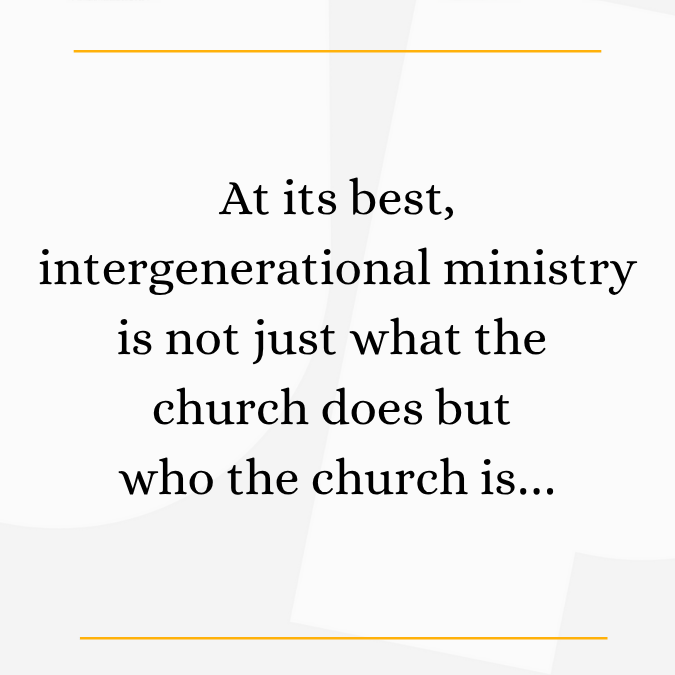What Is Intergenerational Ministry? (And Where to Start)
This practical guide explains key definitions and offers easy, church-ready steps you can start this month—pairing prayer partners, inviting youth into worship roles, and serving/celebrating together to knit an all-age, Christ-centered community.

Community. It’s a buzz word when it comes to church. It often shows up in mission statements and vision boards. But what do we mean by “community?” When we talk about community, we bring with us a lifetime of assumptions and experiences that have formed our understanding of the word. Marvin Minsky once referred to words like “community” or “ministry” as suitcase words—words that carry personal meanings to them so that we often need to unpack them before we can use them well.

Definitions of intergenerational community and ministry
So, when we hear people talk about “intergenerational community” or “intergenerational ministry” what do we mean by that? For our purposes here, let’s establish some working definitions:
Intergenerational community is a gathered group of multiple generations in meaningful relationships with one another, where all have the opportunity both to teach and to learn.
Intergenerational ministry is the intentional culture of a church that creates space for meaningful connections across generations for the purpose of discipleship, faith formation, and community building.
Why it matters: a church-wide posture
There is a common misconception that intergenerational ministry is simply a revamped form of children’s ministry or family ministry. Though these can be natural partners, intergenerational ministry encompasses the whole church—all generations—woven together in a communal and corporate life. It is less a program of the church and more a characteristic of the church, a way of being the body of Christ together.
Not too long ago, the term “intergenerational ministry” was only referred to in smaller, more academic circles. But as more and more research has come out revealing the importance of connecting generations in meaningful relationships, more and more churches are looking to embrace an intergenerational approach. Unfortunately, most of our programming, resources, and traditions tend to keep the ages and generations separated rather than offering opportunities to come together.

How to start without a full revamp
But where to start? A full-program revamp is hardly possible for most churches. But there are some simple steps we can do as we plan our events and consider our programming for the future.
One simple step is to think ahead about who will be present in a particular space or place and think about how we can make it “intergenerational.” A good rule of thumb is to think Past, Present, Future: at least three generations together—the older generation representing the past, the middle generation representing the present, and the youngest generation representing the future. That balance gives depth to our relationships, grounding us in history, connecting us in the present, and giving hope for what is to come.
But simply gathering people of different ages in the same room does not create community. True intergenerational connection requires cultivating meaningful relationships and creating opportunities where each person can be both teacher and student. Each generation has unique gifts to contribute and unique needs that can only be met in relationship with others.
Older generations bring faithful testimonies, treasured worship practices, and disciplines that have sustained communities for decades. Their unique need is to leave a legacy and to be needed; isolation from younger generations denies them this vital expression of faith. (PAST)
Middle generations carry experience with both past traditions and current culture, often bridging communication between worlds. Their need is for intimacy and deeper relationships; without them, they risk withdrawing into isolation. (PRESENT)
Younger generations offer fresh understanding of timeless truths. Their needs are deeply embedded in identity—to know they belong and that their contributions matter. Safe, fun environments are good, but what they long for are participatory environments where they are integral to the life of the church.
Practical ideas you can try this month
So how do we move beyond getting everyone into a room together and into practices that allow intergenerational community to flourish? Here are a few practical examples:
Intergenerational Intercessory Prayer – Programs like The Pray For Me Campaign intentionally link children and youth with prayer partners from older generations. Relationships that begin in prayer often ripple outward into deeper intergenerational bonds across the church.
Inviting Children and Youth in Worship Roles – Worship is more than singing. Hospitality, prayer, generosity, and service are all forms of worship. Giving young people tangible roles in these areas not only helps them grow in faith but also allows the larger congregation to know them by name and story.
Serving and Celebrating Together: Community Beyond the Building – The church is people, not programs. Something as simple as a bulletin board highlighting youth sports, recitals, retirements, or anniversaries can create opportunities for showing up in one another’s lives. Engaging in service projects where multiple ages work side-by-side with each other can bridge generational gaps. Celebrations of milestones across generations help knit the community together outside the pews.

The outcome of intergenerational ministry
Each piece of intergenerational ministry—gathering together, building meaningful relationships, teaching and learning across generations—matters on its own. But taken together, they create something larger: a rich, resilient, Christ-centered community that is more than an event and more than a program. At its best, intergenerational ministry is not just what the church does but who the church is: the body of Christ, living together as past, present, and future, teaching and learning, giving and receiving, worshiping and serving as one family in God.

Christina Embree is the founder and director of ReFocus Ministry and a widely recognized voice in intergenerational ministry and generational discipleship. She holds a Master’s in Ministry (Children, Youth & Family) and a Doctorate in Spiritual Formation focusing on age segregation and intergenerational ministry.
Sign up for your Free Sampler account today!
Get instant access to everything you need, and more than you could ever imagine, for every ministry moment. Thousands of lessons, games, activities, crafts, and worship media assets are ready for you!
Create Free Sampler Account